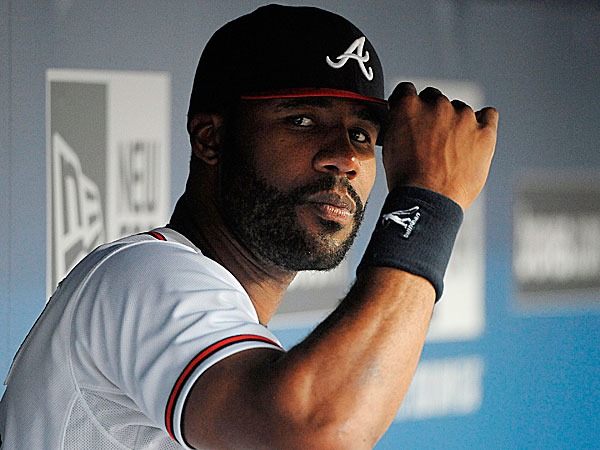Right around noon today the St. Louis Cardinals and Atlanta Braves completed a trade that none of the experts saw coming. The NL franchises swapped Jason Heyward and Shelby Miller in a deal that will fill the Cardinals’ hole in right field and help complete a Braves rotation that has been torn apart by injury and poor performance. At first glance, it’s more of a win for the Cardinals in that it sets them up to win big in 2015, while the Braves have seemingly adjusted their sights to sustained success. Baseball trades can’t be evaluated in a vacuum and we’ve got to dissect the motives of each organization to realize the equity of the trade.
Full disclosure here: I’m a lifelong Braves fan and if I were to chose, I would likely list the Cardinals as my least favorite team. In what follows, I have attempted to remove my fandom from the discussion, and fairly evaluate the trade. I compartmentalize like this in the name of journalistic integrity. Plus, it’d be far too easy to write a #hottake on how much I’m going to miss Heyward.
The Braves had to trade one of Justin Upton and Jason Heyward. Both were set to be free agents after the 2015 season and both are sure to command large investments. With the Braves already signed up long term with Freddie Freeman, Andrelton Simmons, and Julio Teheran, it seemed unlikely that they were to commit to both corner outfield positions as well. With that in mind, and an understanding that whoever traded for Heyward would only be guaranteed one year of his services, a return of a promising young starting pitcher seems like a decent grab.
The Cardinals traded from a position of strength to nab a 5-win player (Heyward has been worth 24.5 wins in his 5 years in the league). He fills the spot that was created when Oscar Tavares tragically passed away in October. The deal leaves the Cardinals with a rotation of Adam Wainwright, John Lackey, Lance Lynn, Michael Wacha and one of Jaime Garcia, Carlos Martinez, or Marco Gonzalez. The rotation’s still formidible, both at the top and through its depth.
Any Braves fan will tell you about the immense amount of talent and potential that Heyward still possesses at the ripe old age of 25. Fans see his laser beam doubles and are waiting for him to put it all together and have a monster year. The year before free agency would be a good idea for the Heyward fortune, but for the purposes of evaluating this trade, one has to assume 2015 will maintain the status quo. He’ll show that potential and possibly top his 11 HR output from 2014, but fail to be a real offensive force. Moreover, he’ll likely only be doing his thing in St Louis for one summer swing. No matter how good he is, the Cardinals are only guaranteed to tap the rewards for 162 games. But in 2015, their lineup will be good. Very good.
This deal really comes down to a single question: what did the Braves get in Shelby Miller?
When looking at his stats, the thing that pops out is his regression in k/9. He went from striking people out as often as Garret Richards or Cole Hamels, to striking people out as often as Kyle Lohse and Jason Vargas. There were rumors of a possible shoulder issue, but his stuff hardly suffered and he made 31 starts in 2014. He went from a 3.06 ERA to a 3.75 ERA and generally wasn’t quite as dominant a force. But, it’s not like he’s surely damaged goods. Since the beginning of August, Miller’s ERA was less than three. He even walked just 2.6 per nine, in line with his first two years. He appears to be a young pitcher still figuring out how to sustain success from start to start and year to year.
The Braves will get Miller for four more years, which is vital in evaluating this trade. He’s 24 and likely capable of repeating the 3.6 win season that he posted in 2013. However, even that high end is lower than Heyward’s average over the last five years.
As for how Miller fits into the Braves rotation, he’ll add stability. Behind Julio Teheran and Alex Wood, the Braves appeared to be leaning on Kris Medlen and Brandon Beachy to both come back strong from their second Tommy John surgeries. Mike Minor will need to be better as he looks to prove that his 3.21 ERA in 2013 was not a fluke. There’s hope with Minor, as he struggled through shoulder stiffness last spring as the result of a surgery to enlarge his urinary tract. (Can’t make that stuff up.) Even with Miller, the Braves fifth starter spot could use a hand. Sure, they always find pitching, but rolling with the two Tommy John guys and David Hale as the fifth starter options, is less than ideal.
If the Braves get 2013 Shelby Miller, they definitely win. If they get 2014 Shelby Miller, well… let’s call it a tie. It’s far more likely that Shelby Miller is a 3.75 ERA pitcher than a 3.06 ERA pitcher, simply because there are only a few guys who consistently throw up 3.06 ERAs. It will be hard to argue next year, if the Cardinals win the World Series and the Braves enjoy a few October tee times, but for now, I think I’m giving the advantage to the Braves on the belief that Miller figured something out in August.
-Sean Morash
Stat of the Day: Only 4 players with over 400 PAs had at least a .400 OBP in 2014. In 2004, that number was 13.5 (Barry Bonds at .609 counts as 1.5).

















